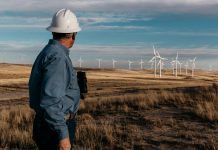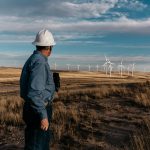The first week in June was a busy one in the renewable energy world, and perhaps even more so among the media that covers energy and policy. That was when the U.S. Environmental Protection Agency (EPA) released its first-ever proposed rule limiting carbon pollution from existing power plants.
In short, the release of the proposed rule was good news for wind energy because the resource is well-positioned to be a leading solution to cutting carbon.
Already Making an Impact
Having dramatically cut the cost of its product (i.e., clean energy), the wind energy industry is already helping every state make progress in cutting their carbon emissions. Already, 11 states have achieved emission reductions of 10 percent or more because of wind and another three states are just below 10 percent.
Just prior to the release of the proposed EPA rule, AWEA released a white paper showing wind energy already helps nearly every state make progress toward carbon reductions and is an affordable and reliable compliance option for further reductions. The white paper found that the 167.7 million megawatt-hours of wind energy produced in the U.S. in 2013 reduced CO2 emissions by 126.8 million tons, the equivalent of reducing power sector emissions by more than 5 percent, or taking 20 million cars off the road.
Achieving 20 percent wind energy, a benchmark outlined in the U.S. Department of Energy’s impending Wind Vision document and in a prior 2008 DOE report, would yield emission reductions of 25 percent.
Wind energy can help states make even more significant reductions, in accordance with the proposed rule — and it can do that while saving consumers money and driving local economic development in the process.
Over the last few years, wind energy has experienced record growth and a major reduction in costs. Wind energy has driven up to $25 billion in private investment in a single year, while the reductions in carbon dioxide emissions and deployed megawatts are rapidly heading upwards.
The cost of wind energy has dropped 43 percent in four years, thanks partly to 560 factories making wind energy components across 44 states. Utilities and other power providers have increasingly been signing contracts for wind energy because they can get long-term, fixed-price deals that help hedge their portfolio against the price volatility of fuel-based sources.
Adopt and Adapt
Thus, American wind power is well positioned to be at the center of efforts to achieve the benchmarks under the proposed EPA rule.
“We hope that this rule makes clear that we have a chance right now to make long-term decisions to lock in affordable power with clean, renewable energy for decades to come,” said Paul Gaynor, CEO of wind energy company First Wind. “Renewable power isn’t only clean, it’s competitively priced. Our customers are already saving millions of dollars by buying wind and solar electricity, and stand to save millions in the years to come. Renewable energy isn’t subject to the price fluctuation that fossil-fuel power is, meaning that the cost savings will last for years to come.”
Notably, stakeholders from various segments of the energy industry are showing openness to the proposed rule. Duke Energy CEO Jim Rogers offered an almost shrugging can-do analysis of the EPA proposal. “I think we’ll find a way to adopt and adapt to the EPA regulations,” he said, speaking at the Annual Conference for Energy Storage in Washington, D.C.
Rogers also expressed concern over rushing to natural gas as the sole solution to meeting the carbon targets set by the new EPA rule. “The gas industry has a history of volatility,” noted Rogers, urging utilities to diversify their resource mix with such options as renewables.
As many utilities across the country know, renewable energy sources like wind power act as a hedge against fossil-fuel price volatility, insulating customers from spikes on their power bill during supply squeezes. In three separate cases during the winter months, wind stepped in to stabilize prices and fill in supply gaps when the cold drove electric demand skyward.
“As one of the biggest, fastest, and cheapest ways to reduce carbon pollution, wind energy can play a central role in state plans to achieve the reduction targets appropriately set by the EPA,” said AWEA CEO Tom Kiernan, responding to the release of the proposed rule. “Reducing carbon pollution through the deployment of wind energy can be done in a manner that keeps electricity affordable and reliable, creates jobs, and supports local economic development.”
|
|
(202) 383-2500 |
|
www.awea.org |
|
info@awea.org |
|
|
AmericanWindEnergyAssociation |
|
@AWEA |
|
american-wind-energy-association |
|
|
www.aweablog.org | ||||



































